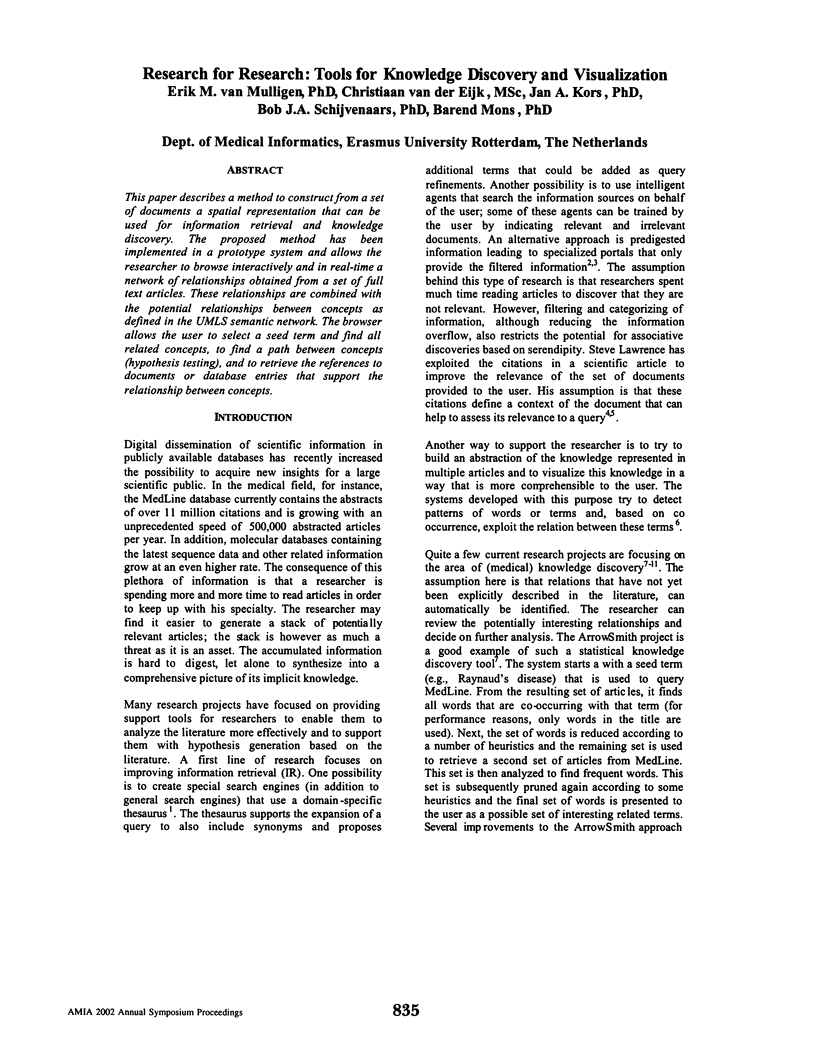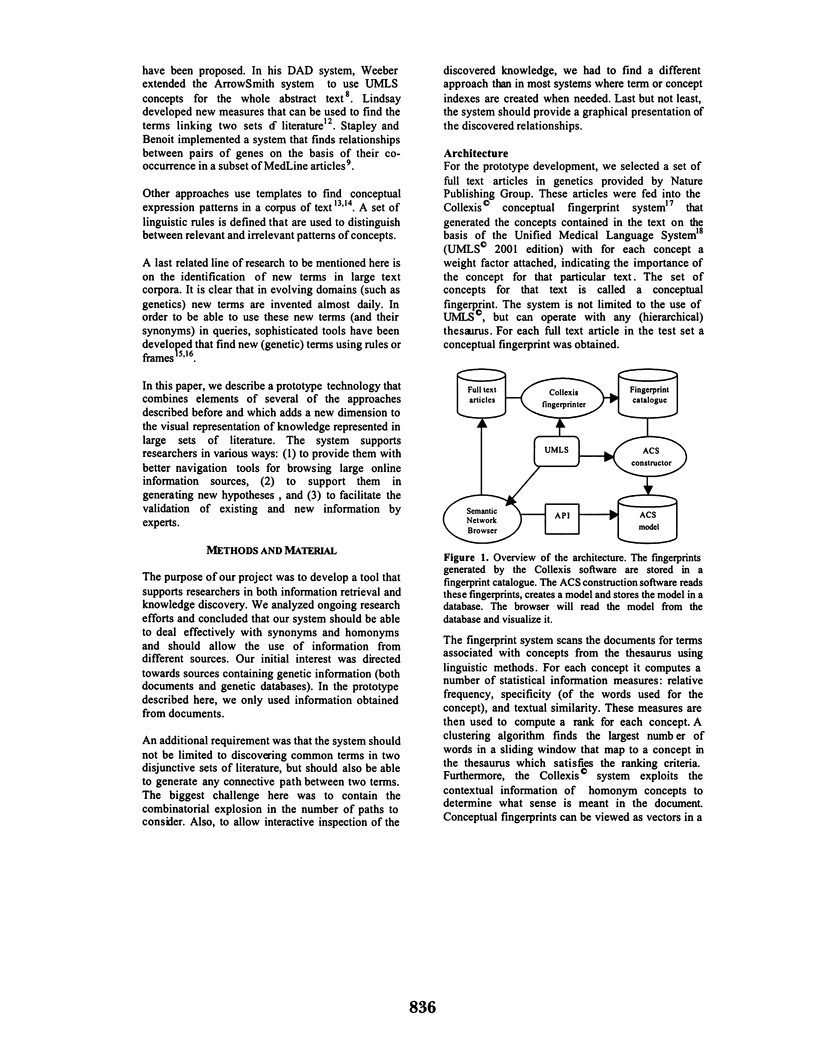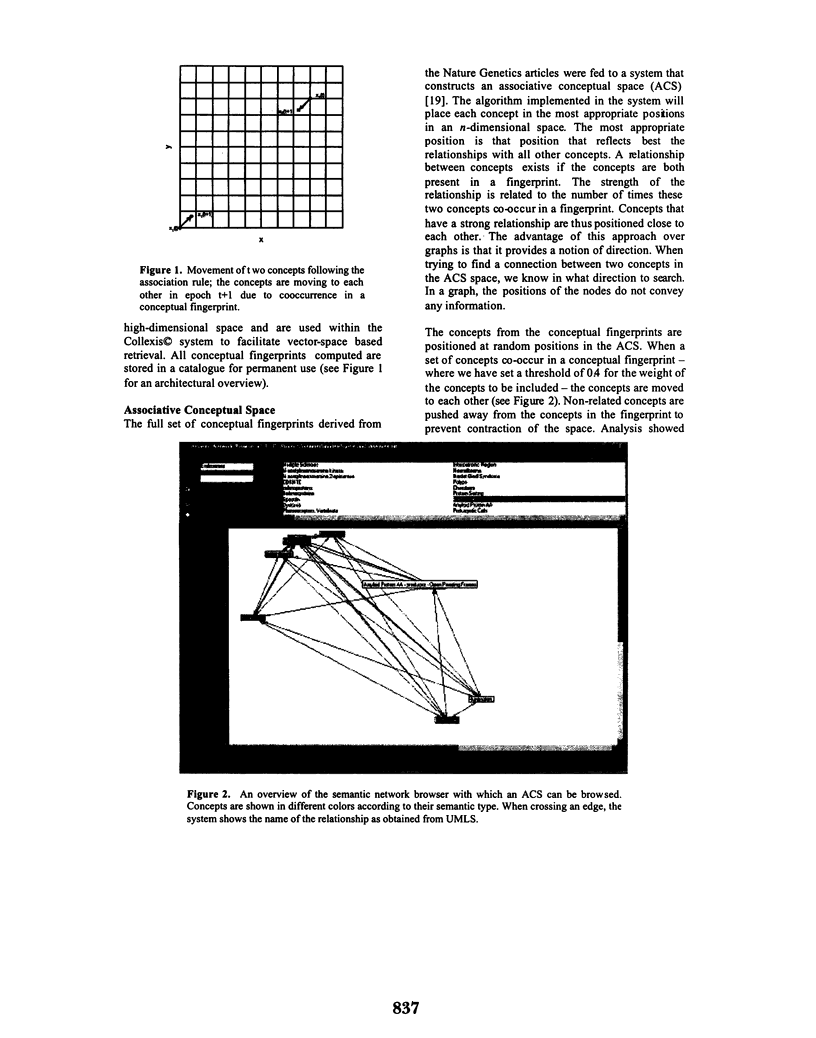Abstract
This paper describes a method to construct from a set of documents a spatial representation that can be used for information retrieval and knowledge discovery. The proposed method has been implemented in a prototype system and allows the researcher to browse interactively and in real-time a network of relationships obtained from a set of full text articles. These relationships are combined with the potential relationships between concepts as defined in the UMLS semantic network. The browser allows the user to select a seed term and find all related concepts, to find a path between concepts (hypothesis testing), and to retrieve the references to documents or database entries that support the relationship between concepts.
Full text
PDF




Selected References
These references are in PubMed. This may not be the complete list of references from this article.
- Craven M., Kumlien J. Constructing biological knowledge bases by extracting information from text sources. Proc Int Conf Intell Syst Mol Biol. 1999:77–86. [PubMed] [Google Scholar]
- Detmer W. M., Barnett G. O., Hersh W. R. MedWeaver: integrating decision support, literature searching, and Web exploration using the UMLS Metathesaurus. Proc AMIA Annu Fall Symp. 1997:490–494. [PMC free article] [PubMed] [Google Scholar]
- Hersh W. R., Brown K. E., Donohoe L. C., Campbell E. M., Horacek A. E. CliniWeb: managing clinical information on the World Wide Web. J Am Med Inform Assoc. 1996 Jul-Aug;3(4):273–280. doi: 10.1136/jamia.1996.96413135. [DOI] [PMC free article] [PubMed] [Google Scholar]
- Joubert M., Fieschi M., Robert J. J., Volot F., Fieschi D. UMLS-based conceptual queries to biomedical information databases: an overview of the project ARIANE. Unified Medical Language System. J Am Med Inform Assoc. 1998 Jan-Feb;5(1):52–61. doi: 10.1136/jamia.1998.0050052. [DOI] [PMC free article] [PubMed] [Google Scholar]
- Lawrence S., Giles C. L. Accessibility of information on the web. Nature. 1999 Jul 8;400(6740):107–109. doi: 10.1038/21987. [DOI] [PubMed] [Google Scholar]
- Lindberg D. A., Humphreys B. L., McCray A. T. The Unified Medical Language System. Methods Inf Med. 1993 Aug;32(4):281–291. doi: 10.1055/s-0038-1634945. [DOI] [PMC free article] [PubMed] [Google Scholar]
- Ng SK, Wong M. Toward Routine Automatic Pathway Discovery from On-line Scientific Text Abstracts. Genome Inform Ser Workshop Genome Inform. 1999;10:104–112. [PubMed] [Google Scholar]
- Rindflesch T. C., Tanabe L., Weinstein J. N., Hunter L. EDGAR: extraction of drugs, genes and relations from the biomedical literature. Pac Symp Biocomput. 2000:517–528. doi: 10.1142/9789814447331_0049. [DOI] [PMC free article] [PubMed] [Google Scholar]
- Sekimizu T, Park HS, Tsujii J. Identifying the Interaction between Genes and Gene Products Based on Frequently Seen Verbs in Medline Abstracts. Genome Inform Ser Workshop Genome Inform. 1998;9:62–71. [PubMed] [Google Scholar]
- Stapley B. J., Benoit G. Biobibliometrics: information retrieval and visualization from co-occurrences of gene names in Medline abstracts. Pac Symp Biocomput. 2000:529–540. doi: 10.1142/9789814447331_0050. [DOI] [PubMed] [Google Scholar]
- Stephens M., Palakal M., Mukhopadhyay S., Raje R., Mostafa J. Detecting gene relations from Medline abstracts. Pac Symp Biocomput. 2001:483–495. doi: 10.1142/9789814447362_0047. [DOI] [PubMed] [Google Scholar]
- van Mulligen E. M., Diwersy M., Schmidt M., Buurman H., Mons B. Facilitating networks of information. Proc AMIA Symp. 2000:868–872. [PMC free article] [PubMed] [Google Scholar]


